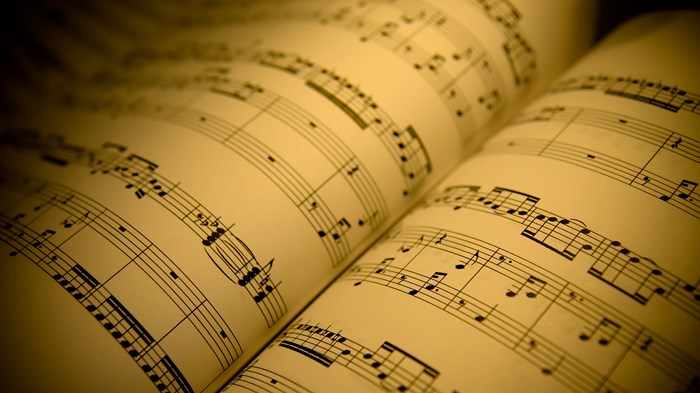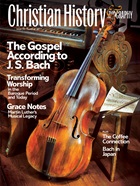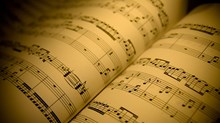
Music flourished in German Protestant churches after the passing of Martin Luther. For the next 200 years, Lutheran composers such as Johann Walter, Michael Praetorius, Heinrich Schütz, and Dietrich Buxtehude put musical flesh and blood on Luther's belief that music was a gift of God. Like Luther, they believed that church music should proclaim the gospel and praise the Creator, be skillfully composed and skillfully performed, and incorporate congregational participation. Their music featured texts from Luther's German translation of the Bible, the liturgy, and popular hymns. The lives and achievements of these four men in particular show that they were not merely "predecessors of the great J. S. Bach" but outstanding Christian musicians in their own right.
Johann Walter (1496-1570)
Luther's musical pioneer
Martin Luther was a fine amateur musician, but he knew he needed professional help in order to carry the gospel to the people. He chose a younger friend, Johann Walter, for that purpose.
Walter's background prepared him well for the challenge. He displayed exceptional musical talent during his school years and published his first work at age 28—a choral collection of a few historic Latin hymns and 23 new German hymns (chorales) by Martin Luther and Walter himself. Luther saw something special in his younger colleague and recommended Walter for the position of musical leader of the Latin school and church in Torgau. Walter thus became the first Lutheran cantor—the forefather of hundreds upon hundreds of Lutheran church-school teachers and church musicians.
At Torgau, Walter set many texts of Luther's German translation of Scripture to music and put into practice Luther's goal of encouraging worshipers to participate more actively in the service by singing the new German chorales. The powerful hymn texts and tunes became popular. Walter and other musicians loved them and embellished them in all kinds of ways for choirs and organ.
Walter was innovative in another way. For centuries during Holy Week, Roman Catholic priests and deacons had chanted the biblical story of Christ's Passion. One person sang the words of the Gospel writer (e.g., John), one sang the words of Jesus, and a third sang the words of all of the other participants. Walter had a different idea. His Passion settings retained the solos of the Gospel writer and Jesus but gave the words of the crowd and other characters to the choir. This kind of conversation between soloists and choir influenced composers for over 200 years.
Walter, like Luther, was convinced that God had created music to carry the message of salvation. In 1538 he wrote a poem called "In Praise of the Noble Art of Music," in which he cited nearly every biblical passage that expressed how music was part of God's revelation. In fact, he declared, of all the arts music most clearly proclaims God's word: "No other arts with it compare, / For it breathes purest Gospel air, / Exalting Holy Writ on high / And earning highest praise thereby."
Michael Praetorius (1571-1621)
Champion of the people's song
Praetorius was a pivotal figure in Lutheran church music—a man of extraordinarily broad interests who respected the old tradition of music for trained choirs yet created new settings of chorales for the people.
The son of a Lutheran schoolteacher who had been a colleague of Johann Walter, Praetorius received musical instruction at the Latin School in Torgau before briefly attending the University at Frankfurt. Apparently, Praetorius never graduated or continued his formal musical education, but he must have demonstrated outstanding ability, for in 1595 he secured a provincial court position as organist at Wolfenbüttel. He became director of the chapel music establishment in 1604. He later traveled widely and attained fame as a performer, composer, and author. By the time of his death, he had also accumulated a considerable fortune—rare for a church musician in any age. He showed his charitable nature by bequeathing funds to set up a foundation for the poor.
Praetorius believed that highly artistic music can communicate Christian faith. He set many traditional liturgical texts to music and often adopted the new Italian technique of having two, three, or even four choirs singing at one time from various places in the church. This produced an impressive stereo effect.
But Praetorius also loved the Lutheran chorale, the people's song, because it gave worshipers a chance to sing the biblical story of salvation in simple language set to singable tunes. He wrote an astounding 1,200 chorale settings for voices and instruments. One of these is "Lo, how a rose e'er blooming," still sung at Christmas today. In many of his pieces, the choir, accompanied by wind and string instruments, sang an artistic setting of the hymn for one stanza, and the congregation responded by singing the next in unison. This practice formed a kind of friendly competition between choir and congregation.
Praetorius also wrote an illustrated, multi-volume encyclopedia of music history, theory, instruments, and church music. It is still considered the most complete and reliable summary of the general musical knowledge and practice of his day.
Heinrich Schütz (1585-1672)
Court musician in love with the Bible
Schütz was born into the well-to-do family of a German innkeeper who later became village mayor. As a boy, his aptitude for music and his beautiful soprano voice earned him the attention of Count Moritz of Hesse-Kassel. Moritz invited Heinrich to attend his new school in Kassel and join his court choir. At Kassel, Heinrich proved his value as a singer and composer so convincingly that Moritz sent him to Italy to learn the modern Italian style of composition.
When Schütz returned, others coveted his services. Finally, in a tug-of-war for musical talent (similar to recruitment competition for modern collegiate athletes), Elector Johann Georg I of Saxony pried Schütz away from Kassel for his court at Dresden, the foremost German musical establishment of the time. Schütz remained in the service of the Dresden court for most of his long and productive life.
Schütz's choral works for the church and court are expressions of his sincere Christian faith and his love of the Bible. Despite his achievements and fame, he was a humble man who suffered much in difficult times. When his 24-year-old wife died, he compensated for his sorrow by composing simple, four-part, hymn-like settings of all 150 Psalms for use in Christian households and by his choirboys in church. When a dear friend and patron died, Schütz created the Musicalisches Exequien (German Requiem), one of the most profound masterpieces of Christian music. Throughout the cruel later part of the Thirty Years' War, his choir members suffered such severe hardships that he supported some of them out of his own pocket.
In happier times, he wrote magnificent settings of the Psalms of praise in the grand Italian style for multiple choirs and instruments—productions only possible because of the financial resources of the Dresden court. He also set many Gospel passages to music for use in the church liturgy. In his 80s, Schütz wrote three masterpieces of sacred choral music, the St. Matthew, St. Luke, and St. John Passions, that are still used by churches during Holy Week. He died an internationally respected Lutheran church musician.
Dietrich Buxtehude (c. 1637-1707)
"Faithful servant" with talented fingers
Dietrich Buxtehude, the greatest organist in the generation before J. S. Bach, was the son of a small-town Danish organist and schoolteacher. He was raised in a conservative Lutheran household with much exposure to music. At the age of 31, after serving at two other churches, he assumed the important post of organist at St. Mary's Church in Lübeck, Germany, which had a magnificent organ with 52 stops. His tenure at St. Mary's lasted nearly 40 years until his death in 1707.
Buxtehude was a virtuoso organist, skilled in improvising. Many of his pieces featured a chorale melody in either simple or highly ornamented arrangements. His very elaborate musical introductions often left the congregation in the dark about exactly which hymn was to be sung next. This confusion led to the practice of posting the hymns (by number) on a board visible to all, a practice that was still common in many churches throughout much of the 20th century.
Buxtehude was a profoundly devout Christian, but also a man of the world. He described himself as a "faithful servant of the church," a fact borne out by the care and skill with which he chose and set to music biblical texts for worship.
Although he did not direct the choir at St. Mary's, Buxtehude wrote many choral works (later called cantatas) that, along with his organ performance, were part of his famous Abendmusiken (Evening Music) events at the church. The celebrated concerts attracted the attention of the 21-year-old Bach, who traveled 280 miles on foot in 1705 in order to attend the Abendmusiken and learn from the aging composer and organist. Buxtehude's music was well known throughout much of Europe. Today, every accomplished organist must be able to perform at least some of his works.
Carlos Messerli is the founding executive director emeritus of the Lutheran Music Program.
Copyright © 2007 by the author or Christianity Today/Christian History & Biography magazine.
Click here for reprint information on Christian History & Biography.

Support Our Work
Subscribe to CT for less than $4.25/month





























